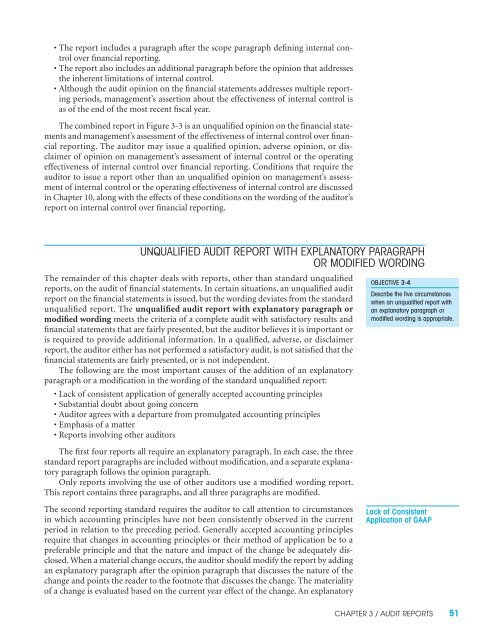audit reports
audit reports
audit reports
You also want an ePaper? Increase the reach of your titles
YUMPU automatically turns print PDFs into web optimized ePapers that Google loves.
• The report includes a paragraph after the scope paragraph defining internal control<br />
over financial reporting.<br />
• The report also includes an additional paragraph before the opinion that addresses<br />
the inherent limitations of internal control.<br />
• Although the <strong>audit</strong> opinion on the financial statements addresses multiple reporting<br />
periods, management’s assertion about the effectiveness of internal control is<br />
as of the end of the most recent fiscal year.<br />
The combined report in Figure 3-3 is an unqualified opinion on the financial statements<br />
and management’s assessment of the effectiveness of internal control over financial<br />
reporting. The <strong>audit</strong>or may issue a qualified opinion, adverse opinion, or di s -<br />
claimer of opinion on management’s assessment of internal control or the operating<br />
effectiveness of internal control over financial reporting. Conditions that require the<br />
<strong>audit</strong>or to issue a report other than an unqualified opinion on management’s assess -<br />
ment of internal control or the operating effectiveness of internal control are discussed<br />
in Chapter 10, along with the effects of these conditions on the wording of the <strong>audit</strong>or’s<br />
report on internal control over financial reporting.<br />
UNQUALIFIED AUDIT REPORT WITH EXPLANATORY PARAGRAPH<br />
OR MODIFIED WORDING<br />
The remainder of this chapter deals with <strong>reports</strong>, other than standard unqualified<br />
<strong>reports</strong>, on the <strong>audit</strong> of financial statements. In certain situations, an unqualified <strong>audit</strong><br />
report on the financial statements is issued, but the wording deviates from the standard<br />
unqualified report. The unqualified <strong>audit</strong> report with explanatory paragraph or<br />
modified wording meets the criteria of a complete <strong>audit</strong> with satisfactory results and<br />
financial statements that are fairly presented, but the <strong>audit</strong>or believes it is important or<br />
is required to provide additional information. In a qualified, adverse, or disclaimer<br />
report, the <strong>audit</strong>or either has not performed a satisfactory <strong>audit</strong>, is not satisfied that the<br />
financial statements are fairly presented, or is not independent.<br />
The following are the most important causes of the addition of an explanatory<br />
paragraph or a modification in the wording of the standard unqualified report:<br />
• Lack of consistent application of generally accepted accounting principles<br />
• Substantial doubt about going concern<br />
• Auditor agrees with a departure from promulgated accounting principles<br />
• Emphasis of a matter<br />
• Reports involving other <strong>audit</strong>ors<br />
The first four <strong>reports</strong> all require an explanatory paragraph. In each case, the three<br />
standard report paragraphs are included without modification, and a separate explanatory<br />
paragraph follows the opinion paragraph.<br />
Only <strong>reports</strong> involving the use of other <strong>audit</strong>ors use a modified wording report.<br />
This report contains three paragraphs, and all three paragraphs are modified.<br />
OBJECTIVE 3-4<br />
Describe the five circumstances<br />
when an unqualified report with<br />
an explanatory paragraph or<br />
modified wording is appropriate.<br />
The second reporting standard requires the <strong>audit</strong>or to call attention to circum stances<br />
in which accounting principles have not been consistently observed in the current<br />
period in relation to the preceding period. Generally accepted accounting principles<br />
require that changes in accounting principles or their method of application be to a<br />
preferable principle and that the nature and impact of the change be adequately disclosed.<br />
When a material change occurs, the <strong>audit</strong>or should modify the report by adding<br />
an explanatory paragraph after the opinion paragraph that discusses the nature of the<br />
change and points the reader to the footnote that discusses the change. The materiality<br />
of a change is evaluated based on the current year effect of the change. An explanatory<br />
Lack of Consistent<br />
Application of GAAP<br />
CHAPTER 3 / AUDIT REPORTS 51
















